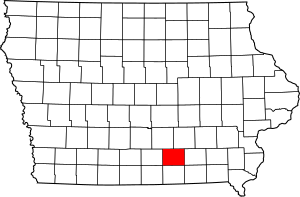National Register of Historic Places listings in Monroe County, Iowa facts for kids
Monroe County, Iowa, is home to some really cool and important historic places! These special spots are listed on the National Register of Historic Places. This is like a national honor roll for buildings, areas, and sites that have a big story to tell about American history. When a place is on this list, it means it's worth protecting and remembering for future generations.
In Monroe County, there are 11 places that have earned a spot on this important list. Let's take a look at some of these amazing historic treasures!
Exploring Monroe County's Historic Treasures
These places help us learn about the past and see how people lived and worked long ago in Monroe County.
Albia Square and Central Commercial Historic District
Imagine the heart of a town where people have shopped, met friends, and done business for many years. That's the Albia Square and Central Commercial Historic District! This area in Albia, Iowa, became a historic district in 1985. It includes many old buildings that show what the town looked like in the past. It's roughly bounded by the alleys of South and North Clinton, East and West A Avenue, North and South 2nd Street, and East and West 2nd Avenue.
Brick Gothic House
This unique house is located just south of Albia. It's called the Brick Gothic House because of its special style, which uses brick and has features often seen in Gothic architecture. It was added to the National Register in 1994.
Buxton Historic Townsite
Buxton was once a thriving coal mining town near Lovilia, Iowa. It was unique because it was a diverse community where many African Americans and immigrants lived and worked together in the early 1900s. Today, the town no longer exists, but the area where it stood is recognized as a historic townsite. It was listed in 1983, helping to preserve the memory of this important place.
Clark Round Barn
Have you ever seen a round barn? The Clark Round Barn, located on County Road T7H near Tyrone, is one of these interesting structures! Round barns were sometimes built because farmers believed they were stronger and more efficient than traditional rectangular barns. This one was added to the list in 1986.
Elbert-Bates House
The Elbert-Bates House is a historic home located at 106 2nd Avenue West in Albia. This house was recognized for its historical importance in 1985. It's a great example of the kind of homes people lived in during earlier times in the area.
Dr. George A. Jenkins House
Another historic home in Albia is the Dr. George A. Jenkins House, found at 223 South C Street. This house, listed in 1987, belonged to Dr. George A. Jenkins. It gives us a peek into the lives of important community members from the past.
Monroe County Courthouse
The Monroe County Courthouse is a very important building in Albia, located on Main Street. Courthouses are often the center of a county's government and history. This grand building was added to the National Register in 1981. It's where many important decisions for the county have been made over the years.
Noble-Kendall House
The Noble-Kendall House is another historic residence in Albia, located at 209 East Benton Avenue. It was listed in 1984. Like other historic homes, it helps us understand the architectural styles and daily life of people from Monroe County's past.
T.B. Perry House
You can find the T.B. Perry House at 212 Benton Avenue West in Albia. This house was added to the National Register in 1983. It's another example of the beautiful and historic homes that make up Albia's rich past.
Saint Patrick's Roman Catholic Church
Saint Patrick's Roman Catholic Church is a beautiful historic church located west of Albia, near U.S. Route 34. Churches often serve as important community centers and hold a lot of history. This church was recognized for its historical value in 1992.
Arvine and Elizabeth W. White House
The Arvine and Elizabeth W. White House is located at 309 North Main Street in Albia. This historic home was added to the National Register in 1994. It tells a part of the story of the White family and the history of Albia.
Images for kids










